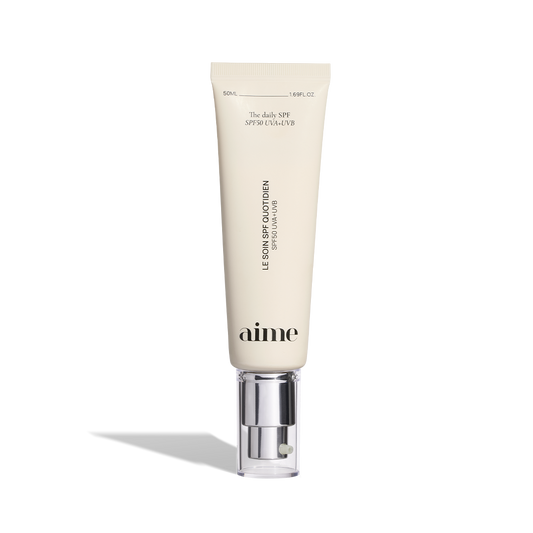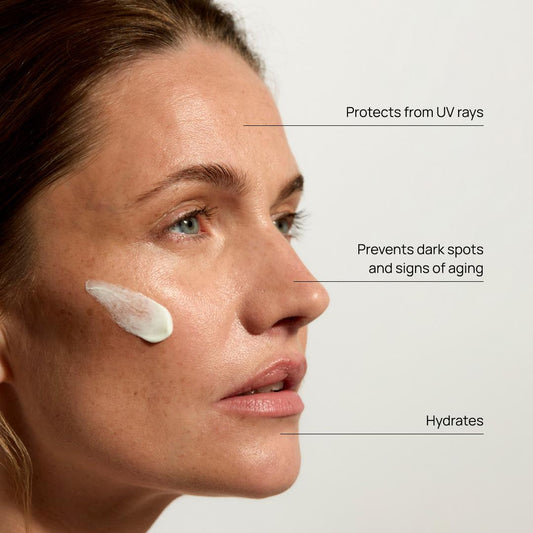Who hasn't noticed areas of the skin on their face, décolleté, or hands that are a little darker than the rest? While these spots generally pose no health risk, they can be a source of aesthetic discomfort for 90% of women affected.
Their origin? They are often the result of a malfunction of melanocytes, the melanin-producing cells, whose activity increases under the effect of UV rays. When the skin is exposed to the sun, it produces a pigment called melanin to protect itself from UV damage. However, prolonged or repeated exposure can lead to excessive melanin production in certain areas of the skin, resulting in brown spots. These spots occur more easily when taking photosensitizing medications, or using perfumes and certain essential oils.
Risky periods: times of hormonal fluctuations, such as a new contraceptive treatment, adolescence with its possible acne outbreaks that leave scars and sometimes spots, or even pregnancy and that famous “mask” that is difficult to get rid of.
What are the different types of stains?
Sun spots or actinic lentigo can appear from the age of 35-40, especially on fair skin that has not been adequately protected from the sun. They appear on photo-exposed areas: face, back of the hands, décolleté... And become more pronounced under the action of UV rays, whether there has been sunburn or not.
On the epidermis, UVA and UVB rays disrupt the microbiota and alter the skin barrier, degrade keratinocytes, and lead to overproduction of melanin, causing oxidative stress and inflammation. The result: poorer cell renewal, thickening of the skin, dehydration, sunburn, and pigmentation spots.
Age spots, which are often found on the backs of the hands, are also lentigo, and have no real connection to skin aging. They simply reflect pigment dysfunction caused by excessive sun exposure.
Melasma is a form of hyperpigmentation that appears as irregular brown spots on the face, usually on the cheeks, forehead, chin, and upper lip. It is often associated with hormonal changes, such as those occurring during pregnancy or due to hormonal contraceptive use.
Post-inflammatory spots appear after skin inflammation, such as acne pimples, rashes, or injuries. They result from an overproduction of melanin in response to inflammation, with a lack of sun protection as new skin forms.
Freckles, more commonly known as freckles, are flat, slightly darker patches on the face than normal skin, which mostly affect people with fair skin. Although not a serious condition, they are usually hereditary and can darken with sun exposure.
How to treat and prevent pigment spots?
It is important to consult a dermatologist to obtain an accurate diagnosis of dark spots and to discuss appropriate treatment options.
However, prevention is often the best way to take care of your skin, namely: effective and regular sun protection as soon as you step outside, especially in the summer.
1. Apply a broad-spectrum sunscreen daily to protect skin from UVA and UVB damage and prevent the formation of dark spots. Avoid excessive sun exposure, especially during the hottest hours. Prepare your skin before and during summer with the Summer Glow supplement for a luminous, even, and long-lasting tan.
“ Prevention is essential ,” says Dr. Sophie Domergue, cosmetic doctor. “I recommend applying a treatment with SPF 50 against UVA and UVB rays every day of the year and in all weather conditions. Even more so before sun exposure. This should be repeated before any sun exposure and every two to three hours, especially on the face, décolleté, and back of the hands. I remind you to avoid sun exposure during the hottest hours, between 11 a.m. and 4 p.m. ”
Newsletter
Subscribe to the newsletter to make sure you don't miss any articles!
2° Focus on antioxidants. Vitamin C is known to even out skin tone and limit the appearance of dark spots. It is found in The Simple Serum by Aime, but also in the new BelightTM Complex of the Clear Glow anti-dark spot food supplement. By combining the power of Grape Seed Polyphenols, Grape Marc Viniferine, Licorice Root Extract and Vitamin C, this biotech active ingredient inhibits tyrosinase, the enzyme responsible for melanin production, by 85%.
The key: this unique synergy corrects hyperpigmentation and regulates melanin production for a lightening action on the complexion, visible from 10 to 15 days.
3. Rely on a dermatologist. If, despite your best efforts, your dark spots persist, only a healthcare professional will be able to guide you toward the most appropriate treatment for your case, whether it's lightening creams, peels, lasers, or microdermabrasion. There are so many personalized treatment options to help fade established spots and restore more even, radiant skin.









